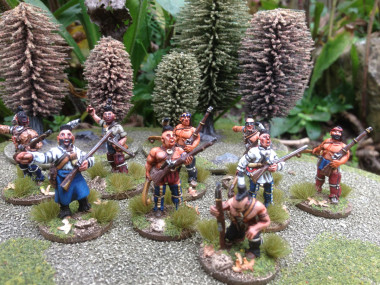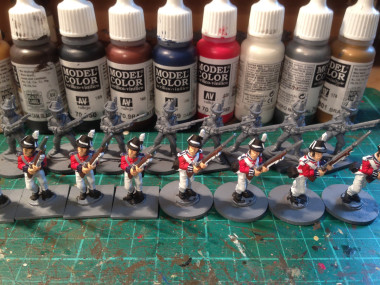After lasts weeks adventure with Lion rampant it’s back to the painting table and the next project from the lead mountain. I have finished my small war party of Woodland Indians and they are waiting for reinforcements before they can take to the table. However, there is no rush to add to the band at the moment. Muskets and Tomahawks are on hold at the club whilst we explore a couple of other options – the Sudan is looking like the favourite at the moment!

Indian War Band
Of course that can be the problem with our hobby. Too many choices and distractions with the result that you can start too many armies and not finish any of them! I will add to my Indian war band in order to finish a skirmishing army for M&T’s. My next purchase will be a couple of packs of Rodgers rangers before deciding on which regular troops to add into the mix.
In the meantime, it’s on with ‘climbing’ the lead mountain that I already have. I would like to be in a position where I have painted everything that I have bought, so that in future, when my wargaming buddies at the club decide to look at another period, I can join in with a few figures of my own fairly quickly. And here’s the point of my ramble. The reason that I have a small lead mountain is that I bought the figures with a project in mind or because I liked them. Not to paint them is just silly. So as I surveyed my collection I saw a batch of Foundry Royal Marines lurking on the pile!
I bought these marines and a naval boarding party for a couple of reasons. They sort of fit in with my plans for the Caribbean force that I have been steadily building (Use this link to bring up a few of my blog posts on this subject). I already have a few ‘Battalions’ of Caribbean troops ready for action and adding a detachment of Royal Navy Marines seems like a good idea. The Royal Navy Marines saw quite a lot of action across the world during the Napoleonic period, obviously fighting in all the major sea battles and of course taking part in all the amphibious actions, particularly in the Peninsular War. In fact on this very day, 8th October, 1806, British forces, including the Royal Marines of course, lay siege to French port of Boulogne using Congreve rockets, invented by Sir William Congreve. They were also very much in action during the war with America in 1812 ( another one of my interests), so having a detachment in my army makes sense.
I also fancied a ‘quick batch paint’ job after getting a bit bogged down painting the Indians. So with this in mind, I cleaned up the first 16 figures ( two packs) primed them with Army Painter grey and got to work painting them. I tend to paint rank and file in batches of six or eight figures. This method allows me to paint one colour on each batch of figures in a reasonable time and stops me getting bored. Using this method I can turn out about 8 figures a week to a reasonable table top standard. As a painting guide, I used the recently published, Issue 4 of Painting War, Napoleonic British Army.

That said, it was more of a colour guide and inspiration rather than a painting guide. I mentioned that I was going to batch paint these figures, which means I will block paint them with the basic colours, shade, using Army Painter Strong Tone, Matt varnish them and then re highlight the lighter colours to give a sharper finish & correct any obvious errors.

Batch Painting Marines
The colours that I am using are shown above. They are all Vallejo Model Color as follows:
70955 Flat Flesh – Face and hands
70950 Black – Hats, Boots, Cartridge box
70822 Black Brown – Hair
70984 Flat Brown – Musket Stocks
70864 Natural Steel – Gun Barrel, Bayonet & Buttons
70947 Red – Jackets
70899 Dark Prussian Blue – Facings ( Collars & Cuffs)
70820 Off White – Webbing, Lace, Trousers
70862 Black Grey – Gaiters & highlights on Black
70801 Brass – Webbing plate, badge on Cartridge box, detail on Muskets.
There are three other colours that I will also use for highlighting, 70996 gold and 70997 Silver to re-highlight and emphasise the metal work, 71077, Wood, to highlight and add detail to the musket stock and 70951 White, to really brighten up and highlight some of the white areas.

Block Painted nearly completed – just Brass to add.
You can see from the pictures above how far I have got with the Marines. They look a bit bland and washed out but the Quick shade will do a lot of the work needed to add depth and detail. The other massive difference will be finishing the bases of course! More to come next week!
